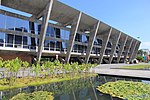Gragoatá
Neighbourhoods of NiteróiRio de Janeiro (state) geography stubs
Gragoatá is one of the 48 administrative districts in the city Niterói, Rio de Janeiro in Brazil. It lies in the southern zone of the city, on the coast of the Guanabara Bay. It holds the main campus of the Fluminense Federal University.
Excerpt from the Wikipedia article Gragoatá (License: CC BY-SA 3.0, Authors).Gragoatá
Rua Passo da Pátria, Niterói São Domingos (Região Praias da Baía)
Geographical coordinates (GPS) Address Nearby Places Show on map
Geographical coordinates (GPS)
| Latitude | Longitude |
|---|---|
| N -22.9 ° | E -43.133333333333 ° |
Address
Campus do Gragoatá
Rua Passo da Pátria
24210-150 Niterói, São Domingos (Região Praias da Baía)
Rio de Janeiro, Brazil
Open on Google Maps










